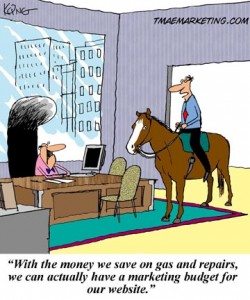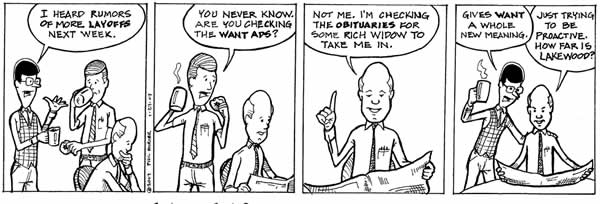I visit a lot of websites. Many of them represent small businesses. And what I see resembles those TV commercials for car dealers featuring the dealership’s owners and employees: a lot of puffery about the business’s owners and their integrity, poorly delivered in a manner that cheapens the reputation of the business itself. In truth, many of these websites, because of substandard design and numbingly boring content, say more about the penny-pinching behavior of the business owners than about the products or services that their business provides. Such a harsh conclusion can be interpreted as an anti-business screed, but that is not my intention.
I am well aware of the economic difficulties facing small businesses during the continuing recession on Main St. (Wall St. is another matter!). To hold costs down, small businesses often resort to stretching or reducing their marketing expenditures. And one way to do that is to accept a cheap, or even free, web development and hosting package that allows a business to establish at least a modest web presence. Such packages come with ready-made templates to which a business owner contributes his/her own content. How can I tell? Because the design and the content together resemble those awful TV commercials. In any event, these websites generally prove to be ineffective. The search engines can’t find them, and customers who stumble across them have difficulty locating the information that they seek.
 The good news is that remedying this situation does not require a business to pay for the services of an expensive media marketing firm that caters chiefly to large corporations. There is no need to acquire a fancy website with a lot of Flash video (search engines hate that anyway). But some expenditure is necessary in order to create a website that is professionally designed so as to make browsing and navigation a pleasant experience. And provison of well-written content that directly meets customers’ most pressing needs will attract more visitors to the site and, therefore, more business.
The good news is that remedying this situation does not require a business to pay for the services of an expensive media marketing firm that caters chiefly to large corporations. There is no need to acquire a fancy website with a lot of Flash video (search engines hate that anyway). But some expenditure is necessary in order to create a website that is professionally designed so as to make browsing and navigation a pleasant experience. And provison of well-written content that directly meets customers’ most pressing needs will attract more visitors to the site and, therefore, more business.
Consider for a moment how most of us are willing, sometimes desperate, to pay for the best medical or dental expertise that we can find. We recognize that an undiagnosed ailment or an untreated tooth infection can kill us, and we decline, therefore, to rely on self-treatment. “But,” one might object, “a professionally created website is not a life-or-death matter.” Really? When some 80% of all potential customers conduct online research before entering a store or contacting a provider, how can a business continue to live without an adequate presence on the internet as part of an effective marketing plan? And if a business dies, how do its owners eat?
Because of this situation, those of us who design or create content for our clients’ websites must do a better job of marketing our own services to those small businesses nearby who are struggling. Our doing so is not only good for our business, but also a way to meet our social responsibility to our business community. And businesses who wish to attract more customers should carefully reconsider their marketing priorities.
